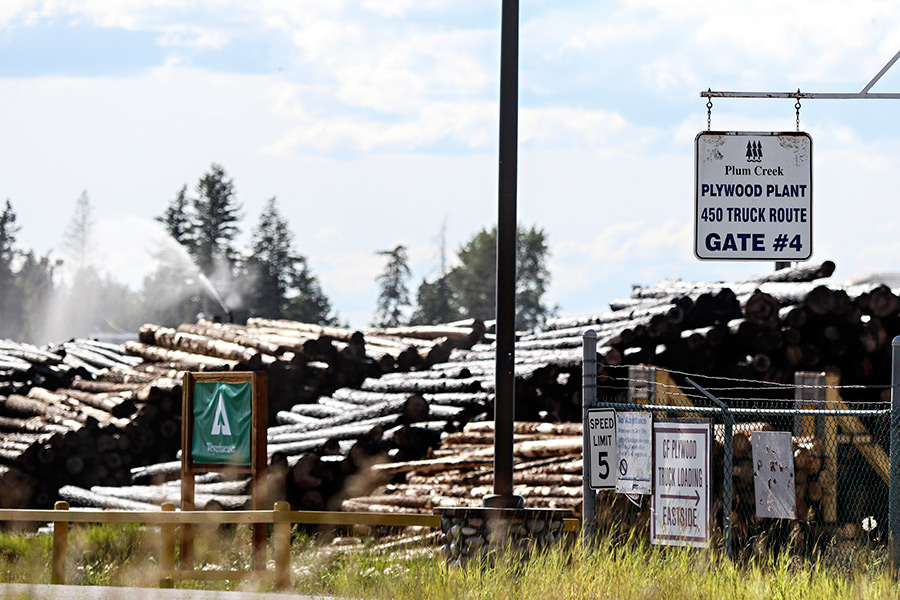As soon as news broke that Weyerhaeuser Co. was shuttering two of its timber mills in Columbia Falls – a move that will eliminate roughly 100 jobs – the staff at Flathead Job Service and administrators at Flathead Valley Community College began laying plans to assist the incoming tide of jobless mill workers.
The closures were announced June 22, just four months after Weyerhaeuser absorbed Plum Creek in an $8.44 billion deal that immediately raised the specter of consolidation and closures.
Although workers said they expected changes, they didn’t think they would be this drastic, or come so soon.
In addition to the 100 jobs lost in the mill closures, Weyerhaeuser is also shifting administrative positions to the Seattle headquarters, meaning the company will close its main office in Columbia Falls by the end of the year and an additional 100 administrative and office jobs will disappear.
It’s a massive hit to a resilient community glimmering with growth following last year’s permanent closure of the Columbia Falls Aluminum Company.
But plans are in place to offer some assistance.
The massive workforce displacement triggered something called the Rapid Response Team of the Dislocated Worker program, a system required under the federal Workforce Innovation and Opportunities Act and administered by state Department of Labor and Industry. The act requires employers who cut more than 50 employees to provide workers a minimum of 60 days notice.
In the case of the Weyerhaeuser layoffs, some 230 jobs will be disrupted, but Tom Ray, Montana resource team leader for the timber giant, said he expects there to be room for about 130 workers to fill shifts at the Kalispell mills.
But come late summer, 100 former mill workers in the Flathead Valley will be in need of employment.
The Dislocated Worker Program helps ease their transition into other fields.
Program director Kathy Yankoff said the rapid response has been triggered following other markers of the timber industry’s decline, including when Tricon Timber in St. Regis announced last September that it was laying off 93 employees, which accounts for more than half the workforce.
Still, the mill closures in Columbia Falls represent the biggest displacement in years, and it will be critical to have resources on hand to aid the jobless.
“The closure up in Columbia Falls is definitely the largest this year,” Yankoff said. “The first step will be to hold group sessions at the mills so that workers know what re-employment services are available, whether that’s help developing a resume, job-search efforts, or helping folks who need some retraining or skill upgrades in order to make a change in their occupation and career path.”
Trevor Gonser, employment specialist at Flathead Job Service, said roughly one-third of the affected workers are over the age of 60, meaning the needs and career paths of the displaced workforce will be varied.
And while Gonser said the market for jobs is strong right now, with about 1,000 positions available throughout the Flathead Valley, lumber mills have traditionally offered some of the highest-paying jobs in the region, and most other jobs available won’t match the mills’ average pay of $22 an hour.
“Plum Creek has traditionally been positioned on the higher end of the wage scale here in the valley, but we are seeing an uptick of wages offered in the hospitality field, but they are not going to rival what these mill workers are making,” Gonser said. “There are a lot of employers who need workers. The economy is doing very good. We are seeing a steady decline in the unemployment rate and a rise in wages.”
Gonser said his team would meet with mill workers on Weyerhaeuser property early next week to provide outreach and education about what options are available to them.
“Our goal is to get out there and be available to these workers and hopefully help meet whatever needs they have,” he said.
Flathead Valley Community College representatives also plan to visit the mill to talk about programs that could match workers with new jobs, President Jane Karas said.
“Within minutes of receiving the notification we held a meeting to develop a strategy for assembling a team to help to get these folks on track toward re-employment,” Karas said.
The team is composed of advisers, recruiters, and teachers, who will visit the mill in the coming weeks to describe programs and scholarship availability.
Karas said the college has helped displaced workers of all demographics re-establish themselves on new career arcs.
Between 2008 and 2010, after the housing bubble burst, Karas said the college saw an uptick in enrollment due to displaced workers.
“We had 700 more full-time equivalent students than we expected, and we helped them become successful in completing a degree and move on to new careers,” she said.
Workers laid off from positions in industry like timber don’t necessarily gravitate toward manual labor, either, but also take advantage of the college’s science, technology, engineering and math programs, as well as computer science.
As of July 1, the program will receive $844,776 in federal funding to help workers who have lost their jobs due to layoffs or closures.
